| A
guitar musician in the plaza plays even while it drizzles.

|
Visitors
can try to pull on a pole stuck in the same tar, to see how difficult it
is for a trapped animal to pull its leg from the tar. The suction is
incredible.

|
Harlan's
Ground sloth (Glossotherium harlani) about 6 feet tall
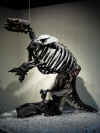

|
Antique
Bison skeleton
(Bison Antiquus)


|

SKULLS of California Saber-tooth (Smilodon
californicus),
Extinct California Condor (Gymnogyps amplus),
Mountain lion (Felis concolor),
Flat-headed Peccary (Platygomus);
Coyote (canis latrans),
Badger (taxidea taxus),
Grey fox (Urocyon cineroargenteus),
Striped skunk (Memphitis memphitis,
Gopher (thomomys),
lizard & snake bones,
Spotted skunk (Spilogale putorius), and
Deer mouse (Peromyscus) |

SKULLS of Extinct Camel (Camelops hesternus)
American Pronghorn Antelope (Antilocapra
americana)
Shasta Ground Sloth (Nothrotheriops shastensis)
Sloth skin bones (Harlan's ground sloth)
Black-tailed jackrabbit (Lepus californicus)
California quail (Lophortyx californicus)
Bones of small birds, and fresh water shells |
| SKULL
of Extinct Western horse (Equus occidentalis)

|
SKULL
& LEG comparisons of BLACK BEAR (Ursus americanus) to an AMERICAN LION
(panthera leo atrox)
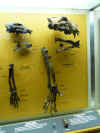
|
SKULLS
of DIRE WOLF (canis dirus), California SABER-TOOTH (Smilodon Californicus)
(Juvenile and young adult)

|
Imperial
MAMMOTH (Mammuthus imperator) - Juvenile milk tooth compared to adult
permanent molar

|
| SKULLS
of Antique bison, and LEG BONES California Turkey (Parapavo californicus)

Antique Bison and Saber toothed cat skulls

|
Life
wear on the California SABER-TOOTH CAT, showing broken & worn sabers,
fused neck vertebrae, healed broken rib, fused back vertebrae; DIRE WOLF -
comparison crippled leg & shoulder bone compared to normal

|
California
SABER-TOOTH CAT skeleton, showing size next to Glenn

|
Extinct
CAMEL skeleton (Camelops hesternus)


|
| American
MASTODON skeleton (Mammut americanum), mother and 6 year old baby


|
THE
HUMAN EQUATION
Cutting edge prehistoric blades were glued to
a wooden handle by asphalt and secured by animal tendons or sea grass
cords. Other artifacts found show how ancient peoples used asphalt
in weapons, lures, tools and utensils


During the Ice Age, the growth of continental
glaciers locked up millions of cubic miles of precipitation that would
normally have gone into the oceans. The absence of this water
lowered the sea level more than 300 feet, creating a land bridge
connecting Asia & North America. Ancient peoples and mammals
crossed the bridge to populate North America.

|

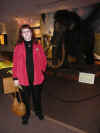
Woolly MAMMOTH (Mammuthus primigenius)
two-thirds of actual size, they are smaller than Columbian mammoths, about
the size of Asian elephants.

|
| Columbian
MAMMOTH skeleton (Mammuthus columbi), this specimen is 12 feet tall



|
Shasta
GROUND SLOTH Skeleton (Nothrotheriops shastense), a browser on shrubs or
low-hanging tree branches


Scapula (shoulder blade) from Giant ground
sloth

|
I
believe this is a Condor

Merriam's Giant CONDOR (Teratornis merriami)
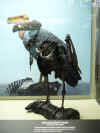
|
La
Brea CARACARA skeleton (Polyborus prelutosus), an extinct long-legged
scavenger related to falcons and caracaras.

|
| California
TURKEY skeleton

|
DIRE
WOLF SKULLS (Canis dirus) an incredible 404 dire wolf skulls
represent only a portion of the more than 1600 wolves' remains found here
at La Brea


|
DIRE
WOLF skeleton, a close relative of the timber wolf but with stronger teeth
and jaws, hunted in packs




|
American
Lion (Felis atrox), a fierce predator larger than the Indian Tiger,
African lion or California Saber-toothed cat


|
| California
SABER TOOTHED CAT skeleton


Diorama of Saber toothed CAT family

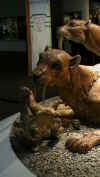
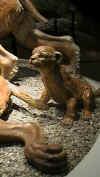
|
Short-faced
bear (Arctodus sinus) now extinct, was a foot taller than the grizzly and
about TWICE its weight


|
An
amazing display of GOLDEN EAGLE (Aquila chrysaetos) FOOT BONES from 1000
birds



|
| One
room, and mirror to show the size of the rooms holding trays of fossils


|
Extinct
Western HORSE skeleton


|
Diorama
of Saber toothed CAT attacking a giant ground SLOTH, as seen by a woolly



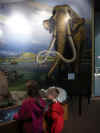
|
| A
near-complete COLUMBIAN MAMMOTH
NAMED "ZED"

being worked on in the Paleontology Lab at the
Page Museum

He had a rough life in the Ice Age, sporting a
couple of broken ribs and a cancerous lesion on his jaw before dying at
the age of 40 (60 is average). Both tusks were found intact (a
rare occurrence).
In 2006, an earth moving machine making a
parking garage close to the Page Museum property came upon the skeleton by
hitting the skull. The museum paleontologists
"tree-boxed" 23 crates of 2-3 million fossils from this site as
quickly as possible, so contractors could continue their work. It is
now called Project 23. For more info, link here to the Page Museum
or read other news articles by typing in "Zed mammoth":
http://www.tarpits.org/project23/
http://www.nhm.org/news/archive/2009/Project23_Press_Release.pdf
More info on Zed below that we documented from
our visit |